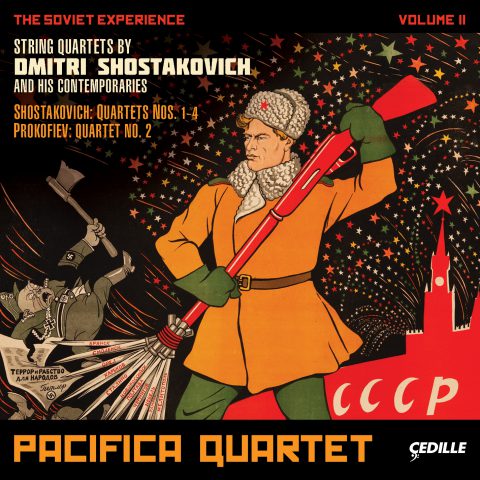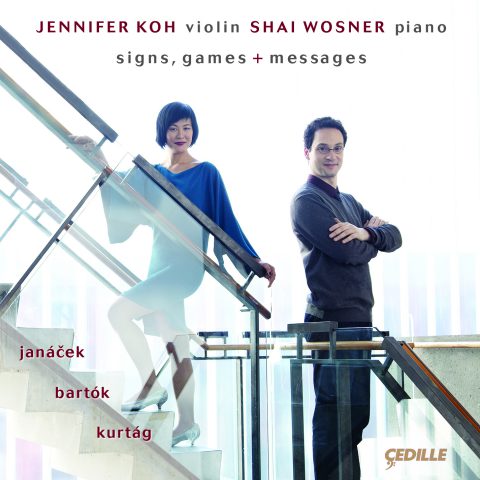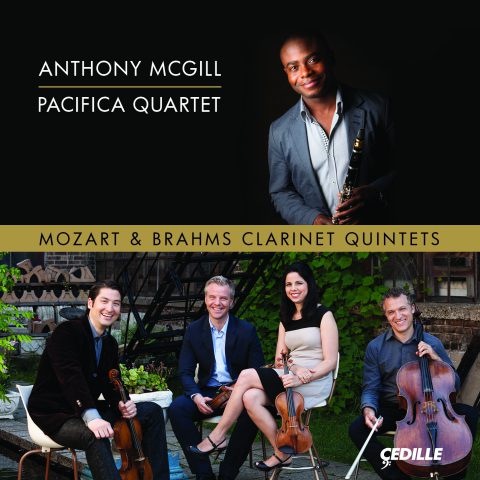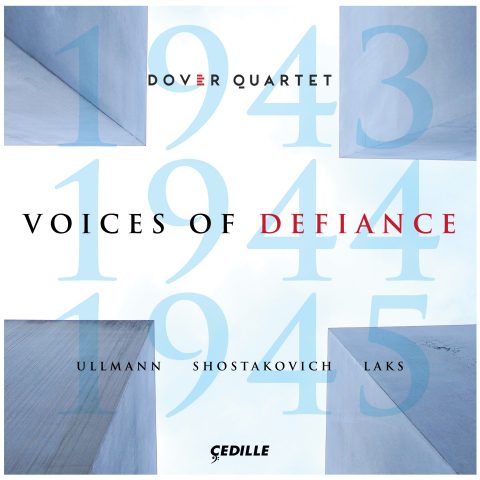| Subtotal | $18.00 |
|---|---|
| Tax | $1.85 |
| Total | $19.85 |
Store
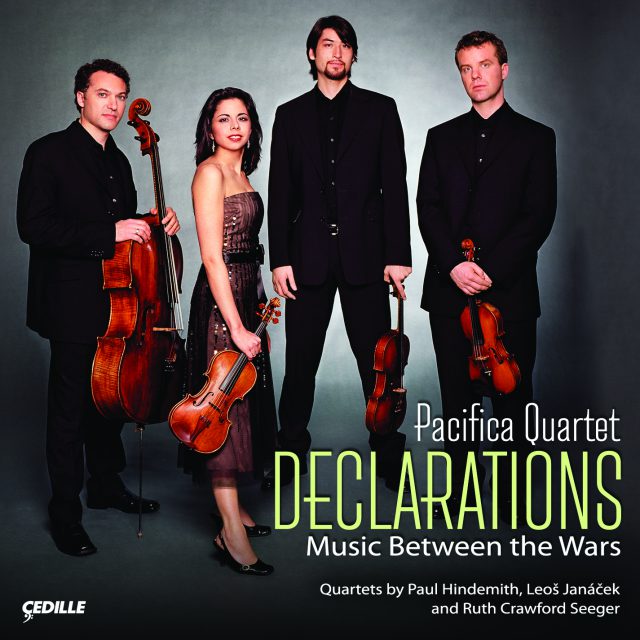
Store
Declarations: Music Between the Wars
On its new CD, Declarations, the Pacifica Quartet mines the artistic ferment of the interwar years with a program of gems from the 1920s and early 30s. Hindemith’s stunning String Quartet No. 4, Op. 22 (1922) takes listeners on an amazing musical journey. Janácek’s fervent String Quartet No. 2 (“Intimate Letters”) from 1928 expresses the mature composer’s white-hot passion for a much younger woman. And the Pacifica revives the most significant composition by American Ruth Crawford Seeger: her dramatic 1931 String Quartet, which noted composer and critic Virgil Thomson hailed as “a noble piece of work.”
The “magnificently polished” (New York Times) Pacifica Quartet delivers precisely what these inventive and emotionally complex works demand: “playing of the most sublime kind, utterly absorbing in its subtle expressiveness.” (London Daily Telegraph). Hear for yourself why so many critics have declared their admiration for the Pacifica Quartet and its musical choices.</p
Preview Excerpts
LEOŠ JANÁČEK (1854–1928)
String Quartet No. 2, "Intimate Letters"
RUTH CRAWFORD SEEGER (1901–1953)
String Quartet
PAUL HINDEMITH (1895–1963)
String Quartet No. 4, Op. 22
Artists
Program Notes
Download Album BookletDeclarations: Music Between the Wars
Notes by Andrea Lamoreux
The life of the oldest, earliest composer on this CD may be briefly summed up as decades of obscurity in a backwater of the Austro-Hungarian Empire followed by a dramatic reversal toward fame and fortune in a newly-established independent nation. Born in a remote Moravian village in 1854, Leoš Janáček was trained as both a musician and a teacher, and spent most of his first 60 years — more than a lifetime, for some people — in the provincial capital of Brno, where he was an organist, choir director, teacher, and folk-music researcher as well as composer. His principal interest was in opera, but he also wrote symphonic and chamber works, plus a great many choral pieces. His operatic efforts were little appreciated. His life was one of continuity, routine, duty, frustration, and surely more than a little boredom. And then, in 1916, in the midst of a world war, the Prague National Opera agreed to produce his opera Jenufa; this was the beginning of his national and international renown, and of his renewed zest for life and art. This “eternally young old man from Brno” (as one biographer put it) wrote, in his sixties and seventies, four more major operas (Katya Kabanova, The Makropoulos Affair, The Cunning Little Vixen, and From the House of the Dead), plus orchestral works, two string quartets, and the Glagolitic Mass.
The inspiraton for this outburst of creativity came from more than his new-found fame; it was spurred greatly by his love for a woman 38 years his junior. Kamila Stösslová, the great love of his life, was the wife of a Bohemian merchant. She never left her husband; Janáček never left his wife. Their affair was apparently conducted largely through correspondence, but its emotional intensity is witnessed by many of the composer’s late works, the string quartets in particular. The inspiration of this love was so great that in the last year of his life, Janáček could declare: “Life is young! It’s spring! I am not afraid to live, to open my eyes, for life is beautiful.”
Janáček’s style fits into no special school or trend; it remains uniquely his own, a blend inspired by many influences: his study of Moravian folk melodies and speech patterns; his interest in other Eastern European cultural heritages, especially those of Russia; and the confluence of Romantic and modernist trends that characterized the early 20th century. The sound world of his second quartet is sharply cut off from its companions on this CD. Hindemith and Crawford Seeger used the ancient genre of the string quartet to speak new musical languages. Janáček, despite the originality of his style, was rooted in the traditions of late Romanticism, and the lushness of his themes and their harmonization recall the larger-scale symphonic works of Mahler and Richard Strauss — neither of them any kind of specialist in chamber music, but composers who spoke with a personal voice in rich harmonies that express very private, very inward emotions in an outwardly expansive way that seeks the universal. A younger Janáček contemporary, Alban Berg, though part of the atonal Schoenbergian school, used chamber music in much the same way: to express deep, often secret, feelings.
Janáček’s first string quartet, from 1923, was subtitled “Kreutzer Sonata”: not a reference to Beethoven’s work with this subtitle, but to a short story by Russia’s Leo Tolstoy, partly inspired by Beethoven’s music, relating the tale of a disastrous marriage. The second quartet, dating from 1928, was originally subtitled “Love Letters,” but the composer pulled back from this too-revealing appellation in favor of “Intimate Letters.” It is a work directly addressed to Kamila, reflecting, as he wrote to her, “the anguish that I feel about you,” and the whole piece is one long instrumental love song. Its frequent shifts of mood reflect the often-sudden changes of feeling and attitude that are experienced in the course of a love affair. Even more evocative of an intimate relationship are the almost constant shifts of tempo, sometimes covering just a few measures at a time before another change of pace ensues. These tempo changes reflect the vicissitudes of a loving but risky relationship: advance and retreat, eagerness and regret.
A Baroque predecessor of our modern viola is the even more mellow-toned viola d’amore, or Love Viola; Janáček originally thought of employing this archaic instrument, but he eventually decided against it. He asks the modern viola player to play “sul ponticello,” near the instrument’s bridge, on numerous occasions; this adds an astringency to the sound that heightens the tension of the emotions being expressed.
The entire quartet is dominated and informed by the motto theme heard at the very beginning. It returns in many permutated forms. It is treated in rondo fashion in the opening movement, which begins at a moderate Andante pace that picks up into a more ardent Allegro. The heartfelt second movement begins at an Adagio pace, very slow, but is interspersed with agitated Vivace passages; here the motto becomes the basis for a set of free variations. The third and fourth movements restate the motto in a number of combinations and variants; the ear is struck once again by the constant variations of tempo. Moderato becomes Adagio becomes Allegro in the third movement, holding the traditional place of a Scherzo; in the emotionally triumphant finale, Allegro slows down to Andante and evolves into an intense Adagio.
In an essay about Hindemith’s works of the 1920s, Musicologist Andres Briner offers an assessment of the composer’s frame of mind in creating a series of miniature concertos with widely divergent instrumentations but the same name: Kammermusik, or Chamber Music. “If ensembles with such differing traditions bear the same title, this can be understood only as a conscious stylistic marking, as a trademark bestowed by the composer,” Briner says. “Hindemith was concerned that these works should already by their title be clearly contrasted with late-Romantic instrumental ensemble music, in which the individual instruments were used above all to produce an atmospheric overall effect, an ensemble of impressionistic tone-values. In the Twenties Hindemith lived and composed in opposition to the Romantics; indeed he was one of the most energetic leaders of this opposition in Germany and outside it too. The rallying-point of this musical activity, as sparing in words as highly active in musical deeds, was [the] Donaueschingen [Festival] in south Germany, where in 1921 were held the first Chamber Music Performances for the Promotion of Contemporary Music. Even in [this designation] there was the password Kammermusik, in very conscious renunciation of the cult of the large symphony orchestra which the late Romantics had pursued in ever-more extravagant fashion.”
Briner’s statements are not an attempt to claim that Hindemith ever rejected the use of large-scale instrumental and vocal resources; two of his greatest compositions, by any standard, are his Symphonic Metamorphoses on themes by Carl Maria von Weber and the opera Mathis der Maler (Matthias the Painter) and the symphony derived from it. But it’s worth remembering that chamber works of various types form a significant percentage of his work-list, from solo sonatas and duo-sonatas with piano to an Octet. Trained first as a violinist, Hindemith later took up the viola and founded his own string quartet, the Amar. He loved performing chamber music as much as he did writing it, and as a soloist, he became a notable viola virtuoso. He wrote two concertos for viola and orchestra — Trauermusik and Der Schwanendreher — and gave the world premiere of Sir William Walton’s Viola Concerto in 1929.
In the years immediately following World War I, European composers recognized that the life they’d previously known had changed irrevocably in all aspects — cultural as well as political and economic. They reflected this cataclysmic change in many different ways. Arnold Schoenberg and his followers developed an entirely new method of pitch and formal organization called serialism, the famous Method of Composition with Twelve Tones that set up arbitrary patterns using all 12 notes of the chromatic scale. Ignoring traditional concepts of melody and harmony, they laid out intricate lines based on endless permutations of the basic 12-tone row, which was not designed to be heard as anything like a recognizable theme. Serialism influenced composers of Schoenberg’s own time, including Ruth Crawford Seeger, and those of succeeding generations, including such major late 20th-century figures as Hans Werner Henze and Alfred Schnittke.
Another major trend was the incorporation of folk music as a basis for concert music, a path followed by Bartók and Kodály in Hungary, Vaughan Williams in England, Falla in Spain, and Copland in the U.S. There was also a thread of mockery and satire, the voice adopted by the young Poulenc and his Parisian associates comprising “Les Six,” and by a young Russian émigré named Prokofiev.
Another Russian émigré, Igor Stravinsky, took a somewhat different view, very similar to that eventually adopted by Hindemith. This approach is generally defined as neo-Classicism: a return to the clarity, transparency, and logical formal structures of the music of the 18th century. Hindemith and other German musicians called it New Objectivity. Unlike the serialists, the neo-Classics did not reject traditional dominant-tonic tonality, though they were much freer in their use of dissonant harmonies than Bach or Haydn. Hindemith, after a few years of exuberant experimentation, decided — and finally declared — that music still needed to have discipline and organization, and to be rooted in the old traditions, while employing the more stringent, less opulent sound qualities characteristic of the new era, in distinct opposition to the lush sonorities of the late Romantics.
When looking to the past for standards of formal organization, Hindemith found particular inspiration in counterpoint: the horizontal combination of independent yet related lines of musical thought, which in his music receives more emphasis than the more vertically-oriented structure represented by chords. The influence of the great contrapuntist Johann Sebastian Bach was so great on Hindemith that numerous commentators have called his style not neo-Classical but neo-Baroque.
The 1920s Donaueschingen Festival, a haven for new music of all types, was the venue for the premiere of Hindemith’s fourth string quartet in 1922. The structures of its five movements borrow and resurrect genres established for many years; the first one is a fugue, a highly organized type of contrapuntal piece, often heard in Bach’s organ music. Hindemith rather modestly labeled the movement Fugato, literally, an almost-fugue. But the standard pattern is clearly there, even if not worked out entirely according to formula. The first violin introduces a meditative, somewhat chromatic theme: in fugue language, this is called the Subject. The pattern is next stated in the viola part — Violin 1 continuing with its own material above — then in the cello, and then in the second violin. Within the space of a few measures, a sinuous sound pattern is being woven.
Hindemith presents a particular challenge to the musicians by writing this and three other movements without a time signature. In most Western concert music, the number of beats to a measure and the basic unit of counting them, usually by quarter notes or eighth notes, is established at the beginning of each movement. A Strauss waltz would start with the numeral 3 over the numeral 4: three-quarter time, three beats written out in three quarter notes per measure, or six eighth notes, or some other subdivision. An unvarying time signature produces a quite regular pulse throughout a movement, but without a time signature, the music is free to progress rhythmically as the composer wills. Hindemith’s score in this first movement contains instructions for numerous changes of pace: slow, slow down, more lively. There are no standard, predictable numbers of notes or rhythmic patterns within a given measure.
The initial fugue subject and its elaborations build up into a strong climax, after which the opening and its ruminative mood are recapitulated, this time with the cello adding new commentary via pizzicato (plucked) figurations.
With only a short pause we are into the brief second movement, a vigorous Scherzo with a gentler midsection, akin to the Scherzo-and-Trio layout so often encountered in the middle movements of Beethoven’s quartets. Interesting rhythmic complexities continue; this time the unit of pace is not the steady quarter-note progression that frequently characterized the Fugato, but the faster eighth note, as in the motive that opens the movement and regularly recurs: five emphatic repeated notes.
The overall shape of this work is an arch form, a structure that also appears in Bartok’s quartets. The intent of an arch form is to make the third movement the structural heart of a work, with the second and fourth movements in strong contrast to it, though related to each other. The first and fifth movements are the solid foundations on either side, and they also are related to each other. In Hindemith’s quartet, the slow third movement is clearly the emotional and structural center. It is the longest movement, its mood is one of serenity and assurance, the strings play with mutes throughout, softening the hard edges of sound, and its main theme — offered first by the second violin over pizzicato accompaniment — is the most tonal, diatonic melody we have heard so far, a lyrical instrumental song. This is also the only movement with a time signature, 6/4: six quarter notes to each measure. This meter has the effect of smoothing out the rhythmic pace and sonority.
The fourth movement, Moderately Fast, is a good-humored parallel to the insistent second-movement Scherzo, except here the focus is squarely on the cello, which is given a virtuosic theme almost akin to the solo cadenzas that highlight concertos. As the first and second movement were linked in time, so there is a link between the end of the fourth movement and the start of the finale, a Rondo whose recurring theme is reminiscent of the fugue Subject of the initial Fugato. The emphasis on linear counterpoint returns here too. The pace is relaxed and the four-way conversation is most congenial.
In her too-brief lifetime, 1901 to 1953, Ruth Crawford Seeger made many different declarations as an artist and as a person. After some fairly traditional early training on the piano, she studied composition with her first mentor, Adolf Weidig, at Chicago’s American Conservatory, and became a firm advocate of all that was new in the music of her time. A second mentor was the iconoclastic American composer Henry Cowell, who helped get recognition for such early modernist works as her Sonata for Violin and Piano. Yet a third mentor was the poet Carl Sandburg, whose children were her piano students; from their father, she gained an interest in American folk music. Also interested in folk music was the composer and musicologist Charles Seeger, with whom she undertook studies in 1929. He became her final mentor, and her husband in 1932. Ruth Crawford Seeger was the stepmother of Pete Seeger and the mother of Mike Seeger and Peggy Seeger, all of whom were leaders in the American folk-music revival of the mid-20th century.
Along the way, Crawford Seeger became the first woman to win a Guggenheim Fellowship for study in Europe. She also won recognition as a composer of formidable and original talent, one whose gender called forth not condescension but admiration from male artists. Her career as a whole shows the importance of both the old and the new in the world of music: the old represented by folk-music research in partnership with her husband, the new by such works as her String Quartet 1931 (originally published by Cowell in his New Music Quarterly).
This is not a quartet in which you can count on recognizable, recurring themes to steer you through and refer back to earlier sections. Three of its four movements are based on fragmented, atonal motives that exploit the highest and lowest ranges of the four instruments in fairly rapid succession. The first movement, has a standard time signature, ¾, but the tempo marking is Rubato, which indicates rhythmic freedom, so the pace increases and decreases as the progression of the motives and the need for expressionstic emphasis dictates. Dissonant intervals like dimished sevenths and augmented ninths abound, in vertical collision and in linear leaps. The motive introduced at the start by the first violin is labeled Solo, and that labeling continues as the motive is passed from part to part. The score indicates that this solo line “must be heard continuing throughout the movement”; indeed it does, and can be heard as such, but it’s often surrounded by much figuration and commentary. Dynamic contrasts are extreme and frequently changing, adding to the sense of frenzied expression and intensity.
The second movement has much the same sound texture, but its pace is different. The tempo marking here is Leggiero, meaning Light and Fleeting. Its role in the work is analogous to that of one of Mendelssohn’s scherzos, although the melodic and harmonic sound of the movement is very un-Mendelssohnian. To be played somewhat faster than the already-fast opening movement, the second has the further indication of Tempo Giusto: exact or strict time. This is a decided difference from the rubato flow of the opening.
The third-movement, marked Andante, shifts into a new realm altogether. Now, instead of rapid rigures constantly shifting up and down, we have sustained notes moving within a very restricted range. Slowly, beginning with viola and cello, then with second and first violins added, the lines progress sometimes by half-tones (A to B-Flat, for example) and sometimes by major thirds (D to F-Sharp). All the instruments begin low in their respective ranges, gradually moving upward in their registers to a climax that’s high-pitched in both the technical and emotional sense. The winding-down of intensity that follows produces a very quiet ending. The score indicates that bowing changes must be unarticulated and almost imperceptible, and that the frequent changes in dynamic level should be as gradual as possible.
The entire effect of this extraordinary movement recalls the Minimalist techniques of the late 20th century: slowly evolving sounds, repetitious yet compelling.
As the third movement dies off into the almost-inaudible, we suddenly are into the short and emphatic finale, to be played As Fast As Possible. Here the first violin is generally set in opposition to the other three instruments, which play muted. As with the first two movements there are sudden and frequent dynamic contrasts, intensified by the music’s almost headlong pace.
Andrea Lamoreaux is music director of 98.7 WFMT-FM, Chicago’s classical-music station.
Album Details
Total Time: 64:38
Producer & Engineer: Judith Sherman
Assistant Engineer & Digital Editing: Bill Maylone
Design: Melanie Germond
Photos of the Pacifica Quartet: Anthony Parmelee
Recorded: September 2-4, 2005 (Hindemith & Crawford Seeger); January 4 & 5, 2006 (Janacek), in the Foelinger Great Hall, Krannert Center, University of Illinois at Champaign-Urbana
Microphones: Sonodor, Neumann KM 130
Publishers:
String Quartet No. 2 by Leo Janacek © 1928 Editio Barenreiter Praha (H 4355)
String Quartet by Ruth Crawford Seeger © 1941 Theodore Presser Co.
String Quartet No. 4, Op. 22 by Paul Hindemith © 1923 Schott Music International
© 2006 Cedille Records/Cedille Chicago
CDR 90000 092
